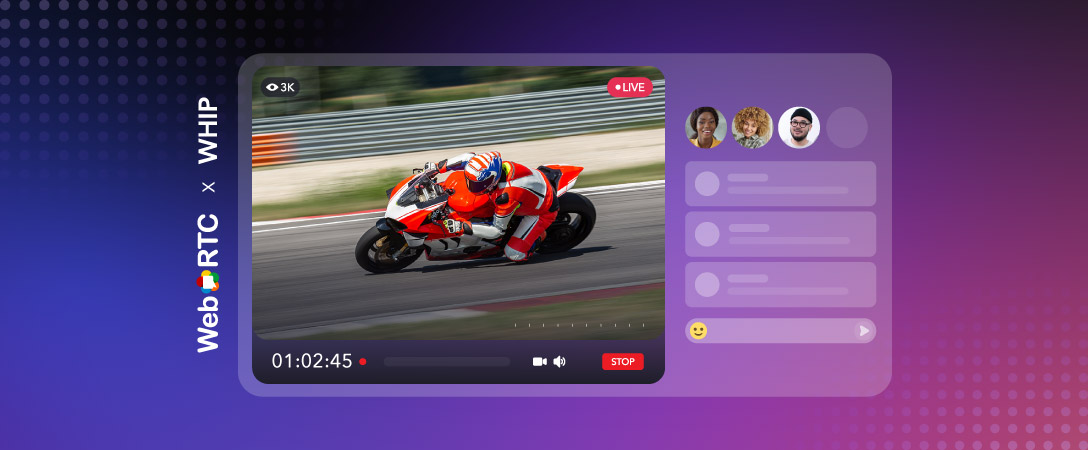WebRTC is one of the hot technologies that broadcasters should consider when deciding which tool to use for their streaming workflows. It unlocks real-time streaming with nearly imperceptible latency, making it suitable for hosting interactive streams that involve user-to-user engagement.
Although it’s a robust protocol, WebRTC has previously faced some challenges that compromised the quality of the experience for both broadcasters and viewers. Fortunately, WHIP, another open-source protocol, was designed to eliminate these issues, allowing media publishers to reap all of WebRTC’s intended benefits.
In this post, we will cover everything you need to know about the WebRTC-HTTP Ingestion Protocol (WHIP), an IETF protocol developed to enable the use of WebRTC for ingesting content into our platforms over legacy protocols.
What is WHIP?
WebRTC-HTTP ingestion protocol (WHIP) is a streaming protocol that enables the creation of high-quality, low-latency streams using WebRTC.
While WebRTC has been around since 2011 and has been successfully used in many scenarios, optimizing WebRTC for live-generated content, such as in the broadcasting industry, differs from optimizing it for pre-existing files, making things more complex.
WHIP (also known as WISH) and WHEP are two new standards designed to facilitate the ingestion and egress of this media into WebRTC, eliminating the need to rely on older standards like RTMP.
How does WHIP work?
WHIP provides a standard signaling protocol for WebRTC, making it easy to support and integrate into software and hardware.
WHIP provides support for essential standards, such as HTTP POST-based requests for SDP O/A, HTTP redirections for load balancing, and authentication and authorization done by the Auth HTTP header and Bearer Tokens.
Think of this like a train station. Without any rail signalers, the trains will behave sporadically, causing potential slowdowns if too many trains are on the same track, unused tracks, and possibly leading to crashes and collisions. With a signaler, the trains will be directed more orderly, optimizing the system to keep things moving quickly and efficiently.
WHIP acts as this signaler, handling tasks such as creating or deleting endpoints as needed and performing operations like Trickle ICE.
4 Benefits of WHIP
In general, WHIP eliminates the translation layers previously required to use WebRTC, thereby smoothing over many of the flaws associated with using WebRTC alone. This provides broadcasters with all the benefits of the protocol without its downsides.
With that said, here are some of the specific benefits of using WHIP for ingestion.
It’s open source
WHIP is open-source, which means it’s highly accessible to broadcasters. Since it’s open source, it’s also completely free to use. The flexibility of this protocol makes it suitable for just about any streaming workflow.
Broadcasters can start publishing their content using WebRTC and WHIP at any time with an open-source software such as GStreamer or OBS (fork).
Ultra-low-latency
A benefit to using WebRTC-based content is its extremely low latency. This is particularly valuable for real-time streaming use cases, such as live sports streaming, online casino gaming, and live auctions, among others.
It’s very secure
WHIP is very secure because it provides end-to-end encryption. This prevents streams from being compromised, creating a higher-quality experience for all parties involved.
High-quality streaming
Initial versions of WebRTC-based streaming were associated with poor quality and limited viewer numbers. However, WHIP tremendously improves streaming quality and it’s scalable. This helps create richer experiences for larger numbers of viewers.
WHIP and Dolby OptiView
As mentioned before, WHIP is an open standard. Dolby OptiView supports WHIP not only by providing integrations, but also by leading the definition and research into the standard.
Our researchers have developed this standard, and our engineers have implemented it in our streaming platform. Additionally, we have worked directly with software and hardware partners to integrate this standard into their platforms, such as FlowCaster and Osprey, for both software and hardware encoding.
Final thoughts
WHIP is the future of WebRTC ingestion, and we want to support the development and community around it, as a standard is nothing without broad adoption. We encourage you to try out WHIP today to reap the benefits in your next streaming project.
Real-time streaming with WHIP, WebRTC, and other powerful technologies can help you supercharge your streaming experiences to offer interactivity and foster community engagement. Contact us today to learn more about how our streaming solution can help you create richer streaming experiences for your audience.








